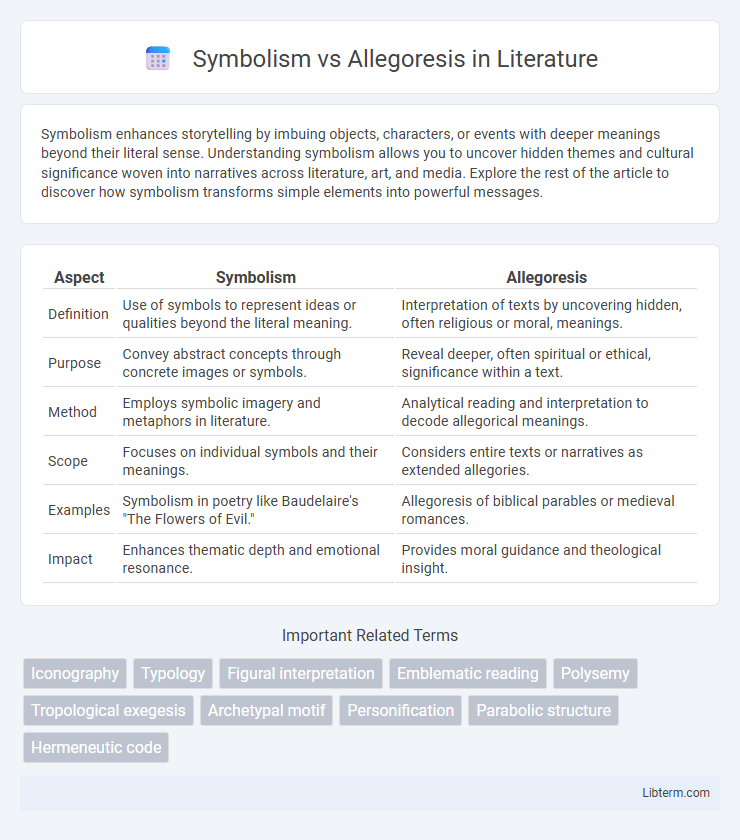Symbolism enhances storytelling by imbuing objects, characters, or events with deeper meanings beyond their literal sense. Understanding symbolism allows you to uncover hidden themes and cultural significance woven into narratives across literature, art, and media. Explore the rest of the article to discover how symbolism transforms simple elements into powerful messages.
Table of Comparison
| Aspect | Symbolism | Allegoresis |
|---|---|---|
| Definition | Use of symbols to represent ideas or qualities beyond the literal meaning. | Interpretation of texts by uncovering hidden, often religious or moral, meanings. |
| Purpose | Convey abstract concepts through concrete images or symbols. | Reveal deeper, often spiritual or ethical, significance within a text. |
| Method | Employs symbolic imagery and metaphors in literature. | Analytical reading and interpretation to decode allegorical meanings. |
| Scope | Focuses on individual symbols and their meanings. | Considers entire texts or narratives as extended allegories. |
| Examples | Symbolism in poetry like Baudelaire's "The Flowers of Evil." | Allegoresis of biblical parables or medieval romances. |
| Impact | Enhances thematic depth and emotional resonance. | Provides moral guidance and theological insight. |
Understanding Symbolism: Definition and Origins
Symbolism is a literary and artistic device that uses symbols--objects, characters, or colors--to represent abstract ideas or concepts, originating from ancient cultures and flourishing in 19th-century art and literature. Rooted in philosophical and psychological theories, symbolism conveys deeper meanings beyond the literal, often evoking emotions and thoughts through metaphorical association. Its origins trace back to early mythologies and religious rituals, evolving into a complex system that enhances thematic depth in literature and visual arts.
Allegoresis Explained: Decoding Deeper Meanings
Allegoresis involves interpreting texts to uncover hidden, symbolic meanings beyond the literal narrative, often revealing moral, spiritual, or philosophical insights. This method decodes layered messages by reading characters, events, or settings as representations of broader concepts or truths. Unlike straightforward symbolism, allegoresis demands a systematic approach to unravel complex allegories embedded within literary, religious, or artistic works.
Historical Contexts: Symbolism and Allegoresis in Literature
Symbolism in literature emerged prominently during the late 19th century as a reaction against realism, emphasizing metaphorical imagery to evoke emotions and ideas beyond the literal narrative. Allegoresis, rooted in ancient and medieval traditions, involves interpreting texts to uncover hidden moral, spiritual, or political meanings, especially prevalent in biblical exegesis and medieval allegorical works. Historical contexts reveal symbolism as a modern, artistic movement prioritizing subjective experience, while allegoresis functions as a methodical interpretive practice embedded in historical didactic and religious frameworks.
Key Differences Between Symbolism and Allegoresis
Symbolism involves the use of symbols to represent ideas or qualities, often conveying deeper meanings through a single image, object, or figure. Allegoresis, on the other hand, refers to the interpretative process where an entire narrative or text is understood as an extended metaphor with multiple layers of meaning. Key differences include symbolism's focus on individual symbols versus allegoresis's broader interpretative framework that deciphers the underlying moral, spiritual, or political significance in a text.
Cultural Significance of Symbolism Across Eras
Symbolism has played a crucial role in human culture, serving as a bridge between tangible objects and abstract ideas throughout history. From ancient Egyptian hieroglyphs to Renaissance art and modern literature, symbols encapsulate collective beliefs, values, and spiritual ideals that transcend time and geography. Unlike allegoresis, which interprets text through layered narratives, symbolism communicates meaning directly through universally recognized icons and motifs, embedding cultural identity within its forms.
Allegoresis in Religious and Philosophical Texts
Allegoresis involves interpreting texts by uncovering deeper, often spiritual or moral meanings beyond the literal sense, playing a crucial role in religious and philosophical traditions. Religious scriptures such as the Bible and the Quran employ allegoresis to convey theological concepts, enabling believers to derive ethical guidance and divine truths. Philosophers use allegorical interpretation to explore abstract ideas and existential themes, enriching textual analysis by revealing layered significance.
Techniques for Identifying Symbolism vs Allegoresis
Techniques for identifying symbolism involve analyzing objects, characters, or events that represent broader abstract ideas or concepts, often relying on cultural or contextual clues. In contrast, allegoresis requires interpreting an entire narrative or text as a cohesive metaphor, where each element corresponds to a specific principle or moral, necessitating a systematic deconstruction of the narrative layers. Recognizing symbolism hinges on isolating individual symbolic elements, whereas allegoresis demands understanding the interconnectedness of symbols within the overarching moral or philosophical message.
Notable Works Showcasing Symbolism and Allegoresis
Notable works showcasing symbolism include Nathaniel Hawthorne's "The Scarlet Letter," where the scarlet letter 'A' symbolizes adultery, guilt, and social judgment, and William Golding's "Lord of the Flies," which uses the conch shell as a symbol of order and civilization. In contrast, allegoresis shines in John Bunyan's "The Pilgrim's Progress," an extensive allegory representing the Christian journey of salvation, and George Orwell's "Animal Farm," a political allegory critiquing totalitarianism through a farmyard revolt. These works demonstrate how symbolism creates layers of meaning through specific symbols, while allegoresis uses entire narratives to convey deeper moral or political messages.
The Role of Reader Interpretation in Symbolism and Allegoresis
Reader interpretation plays a crucial role in symbolism by allowing individuals to extract personal and culturally influenced meanings from symbols, which often remain open-ended and nuanced. In allegoresis, the reader engages with a more structured and consistent framework, decoding layered narratives that convey moral, spiritual, or political messages through extended metaphorical representation. Both approaches depend on the reader's ability to connect text elements with broader contexts, but symbolism invites more subjective interpretation while allegoresis guides readers toward a specific, author-intended meaning.
Contemporary Relevance: Symbolism and Allegoresis Today
Symbolism and allegoresis remain vital in contemporary art and literature, serving as tools to convey complex social, political, and cultural messages. Symbolism uses icons or motifs to evoke abstract ideas and emotions, while allegoresis interprets texts or artworks to reveal hidden moral or philosophical meanings. The interplay between these methods enhances critical engagement and deepens understanding of modern narratives and visual media.
Symbolism Infographic

 libterm.com
libterm.com